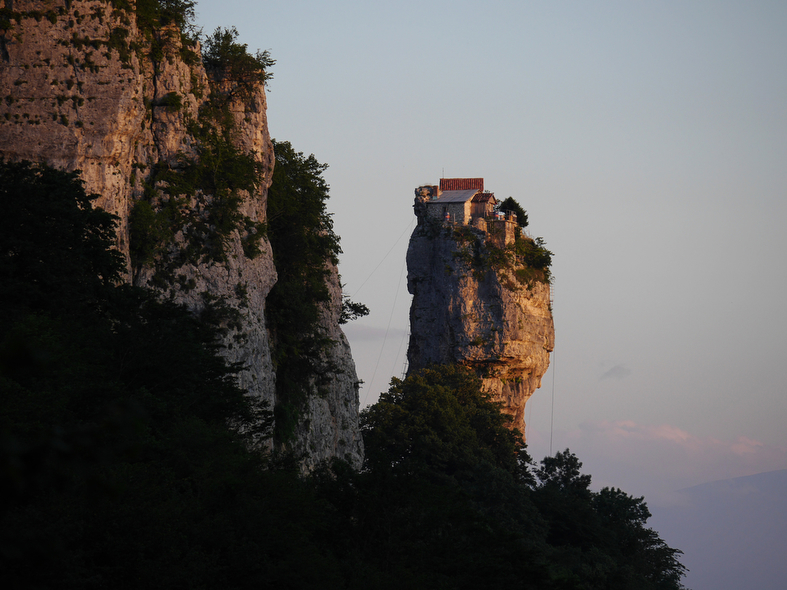
(cnnphotos.blogs.cnn.com) Maxime the monk lives on a pillar. When he wants to step down out of the clouds, the 59-year-old scales a 131-foot ladder, which takes him about 20 minutes.
After living on Katskhi pillar for 20 years, Maxime’s climbs have slowed, but having worked as a crane operator in a past life, he’s never feared heights.
Photographer Amos Chapple heard about Maxime while working in the country of Georgia, and when he first arrived and asked to go up, he was told no. Only priests and some of the troubled young men learning from Maxime and living in a monastery underneath the pillar were allowed to go up.
Chapple stayed with the men at the base for four days before he was told he could ascend the pillar. He participated in prayers seven hours a day, including four-hour night prayers from 2 a.m. to sunrise. When he was finally going up to Maxime’s home, rain clouds rolled in and the sun was setting. The iron ladder was “very dicey,” Chapple said.
“I put so much time into getting permission that I said it was too late to be scared,” he said.
While with Maxime at the top, Chapple said he was worried he would run out of light for the climb down and that it would start raining, but as he looked out at the clouds at eye level and the distance between he and the ground, he appreciated the quiet of the elevated home.
“You could feel one with the weather,” he said.
Maxime said he needs the silence of the top of the pillar.
“It is up here in the silence that you can feel God's presence," he told Chapple in Russian.
Stylites, or pillar saints, began after Simeon Stylites the elder in Syria first moved atop a pillar in 423 to cut himself off from worldly temptations. Stylites were most common in eastern Europe during the latter part of the fifth century, but the practice has since been abandoned.
Katskhi pillar had sat idly since the 15th century when the Islamic Ottomans invaded Georgia. No one had even been to the top for centuries until an alpinist climbed it and found the remains of a chapel and the skeleton of a Stylite in 1944.
Maxime told Chapple he “drank, sold drugs, everything” as a young man. After serving time in prison, he decided he needed a change.
“I used to drink with friends in the hills around here and look up at this place, where the land met the sky,” Maxime told Chapple. “We knew the monks had lived up there before, and I had great respect for them.”
Maxime took monastic vows in 1993 and climbed the tower to start a new life. For the first two years, he slept in a fridge to protect himself from the elements. He now has a bed inside a cottage where he sleeps.
“It’s more about the isolation than suffering,” Chapple said.
Followers send supplies up to Maxime with a winch, and the monk comes down once or twice a week for night prayers with the men staying at the monastery.
His climbs have slowed, and once Maxime is no longer able to move up and down the ladder, he will stay at the top until he dies.
A crypt holding the bones of a Stylite who lived and died at the Katskhi pillar lies under the chapel.
When Chapple asked Maxime if his bones would be stored in the same crypt, Chapple said the monk stretched out his arms in his charismatic way and said, “Of course!”
– Lauren Russell, CNN
Amos Chapple | Maxime The Pillar Saint [thetravelphotographer.blogspot.de]
 I have no chance of being a Stylite saint...(or being a saint for that
matter) since I feel uncomfortable with heights. Not to the extent of
being acrophobic, but enough that I think twice before looking out of a
skyscraper balcony or even floor to ceiling windows.
I have no chance of being a Stylite saint...(or being a saint for that
matter) since I feel uncomfortable with heights. Not to the extent of
being acrophobic, but enough that I think twice before looking out of a
skyscraper balcony or even floor to ceiling windows.CNN featured a photo essay by Amos Chapple on Maxime, a monk who lives on a mountain pillar in the country of Georgia. To get to his aerie where he lived for 20 years, the 59-year-old scales a 131-foot ladder, which takes him about 20 minutes.
Maxime follows the ancient tradition of the Stylites (aka Pillar-Saints), a type of Christian ascetics who in the early days of the Byzantine Empire stood on pillars preaching, fasting and praying. They believed that doing so would ensure the salvation of their souls. The first Stylite was Simeon who climbed a pillar in Syria in 423 and lived there for 39 years until his death.
The monk told Chapple that it was up on his perch that he could feel God's presence. The pillar is called Katskhi pillar, and stood unvisited since the 15th century when the Ottomans invaded Georgia. No one had even been to the top for centuries until an alpinist climbed it and found the remains of a chapel and the skeleton of a Stylite in 1944.
Amos Chapple started as a newspaper photographer in New Zealand, including two years at the country’s largest daily, The NZ Herald, before moving to London and working full-time for a project to photograph all of the world’s UNESCO World Heritage Sites. He now works freelance and, as of the past year, has been specializing in photographs of the world’s ”beautiful secrets”. It’s a kind of travel photography, but by making sure each site is little-known, and has an interesting back story, it is proving popular with newspapers and magazines throughout Europe











No comments:
Post a Comment